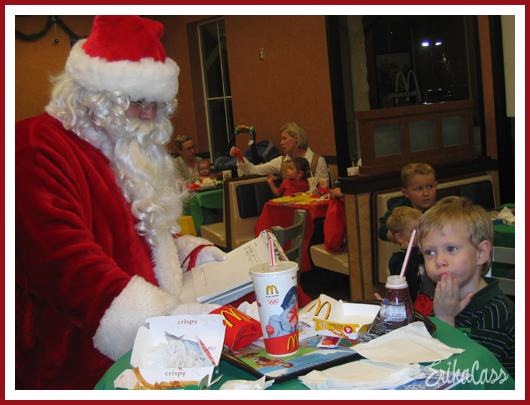The Legend of Santa Claus
The character we know as Santa Claus, is a blend of many different cultures, customs, legends and mythological creatures. His earliest ancestors date back to a time when the earth was ruled by sky-riding gods. But much of his legend is based on the life of St. Nicholas, a fourth century bishop from Patara, in what is now Turkey.
The mythological characters of Odin, Thor and Saturn gave us the basis for many of Santa's distinctive characteristics. St. Nicholas' appearance was transformed into the image of the fat, jolly winter spirit reminiscent of the ancient Nordic/Teutonic god Odin.
The basis for the Christian Era Santa Claus is Bishop Nicholas. The Orthodox Church raised St. Nicholas to a position of great esteem. The Roman Catholic Church honoured Nicholas as one who helped children and the poor. St. Nicholas became the patron of children and seafarers. His feast day is December 6, and was commemorated with an annual feast which eventually marked the beginning of the Medieval Christmas.
St. Nicholas was legendary for his kindness and generosity and was a champion of children and the needy. Through his benevolence we find the two basic principles of the holiday spirit - giving to others and helping the less fortunate - as well as the tradition of hanging stockings by the chimney. According to one legend, there were three Italian maidens whose father had lost his fortune. The three maidens were to wed, but their father couls not afford the dowries that were necessary. When St, Nicholas heard of this, he went to their home late one night and tossed three bags of gold down the chimney. The bags miracously landed in each of the sisters stockings, that were hung by the fire to dry. A variation of this story, is that as each girl was to wed, he anonymously tossed a bag into an open window. This may have been used as a way of explaining how Santa Claus delivers gifts to homes that have no chimney.
After the Protestant Reformation of the sixteenth century, the veneration of Catholic saints was banned. But people did not want to give up their annual visits from the gift-giving saint, and they did not want to forget the purpose of the holiday. In some countries the festivities of St. Nicholas Day were merged with Christmas celebrations. St. Nicholas underwent a transformation into a new, non-religious form, but he retained his generous spirit.
In Germany, he appeared as Weihnachtsmann, in England as Father Christmas, and in France as Pere Noel. In areas where St. Nicholas was still seen as a gift-giver, he developed a host of other characters as helpers. Two of his most famous helpers were Knecht Ruprecht and the Belsnickle. Depending on the location, they were either helpers or St. Nicholas himself, but in all cases they were fearsome characters. It was not only their duty to reward good children but also to punish naughty ones.
Knecht Ruprecht, meaning Servant Rupert, was also known by other names, such as Black Peter, so called because he delivered presents down the chimney for St. Nicholas and became blackened from the soot. In some places the image of St. Nicholas merged with Knecht Ruprecht to form Ru Klaus, meaning Rough Nicholas, so named because of his rugged appearance; Aschen Klaus, meaning Ash Nicholas because he carried a sack of ashes and a bundle of switches; and Pelznickle, meaning Furry Nicholas, referring to his fur-clad appearance. The Pelznickle was also known as the Rider of the White Horse, which was one of the names given to the Nordic god Odin. This name indicates the northern influence in these legends, and shows that the debased god was still alive in the folk beliefs that had been suppressed by Christianity.
Not all of St. Nicholas' companions were frightening. In fact, the Christkindl, meaning Christ Child, was thought to accompany him in many countries. Often seen as a fair-haired young girl, this angelic figure was sometimes the gift-giver also.
Immigrants to the New World brought along their beliefs and customs: Scandinavians brought their gift-giving elves and Germans brought Belsnickle and Christkindlein (and their decorated tree). The American Santa Claus figure received his name from the Dutch. During the 1600s the Dutch introduced Sinterklaas. Many of the English speaking children mispronounced the name as Santy Claus. After many years of this mispronunciation, Sinterklaas became anglicized into Santa Claus.
In 1808, the American author Washington Irving created a new version of the old St. Nicholas. In his History of New York, Irving gave the first detailed description of the Dutch St. Nicholas. He described the arrival of the saint on horseback, this one rode over the treetops in a horse drawn wagon, dropping gifts down the chimney. He also described Santa as a Dutchman who smoked a long stemmed pipe, wore baggy breeches and a broad brimmed hat.
The Dutch-American Santa Claus achieved full Americanization in 1823 in a poem 'A Visit from St. Nick' (The Night Before Christmas) by Clement C. Moore. His poem gave an Arctic flavor to Santa Claus's image. He substituted eight tiny reindeer and a sleigh for the horse and wagon. He included such details as Santa's wink, nod, laugh and the myth by which the 'jolly old elf' returns up the chimney. It is Moore's description that we think of today: "He had a broad face, and a little round belly, that shook when he laughed, like a bowl full of jelly."
In 1863, a German immigrant, Thomas Nast, gave a visual image of the jolly gift-giver that was to become widely accepted. He depicted a rotound Santa for Christmas issues of Harper's magazine from the 1860s until the 1880s. When Nast was asked to illustrate Moore's verse for a children's book, he showed us a softer, kinder Santa who was still old but less stern than the ecclesiastical bishop St. Nicholas. He dressed this elfin figure in red and endowed him with human characteristics. Nast added such details as Santa's workshop at the North Pole and Santa's list of good and bad children.
In 1931, artist Haddon Sundblom added the final touches to Santa's modern image and the legend. On billboards and advertisements for Coca Cola, Sundblom featured a portly, grandfatherly figure with human proportions and a ruddy complexion. The elf of Moor'es poem was replaced with a human sized, exhuberant, twinkle-eyed Santa Claus.
In the modern version of the Santa Claus legend, only Santa's toy shop workers are elves. There is also a ninth reindeer - Rudolph - who has a shiny red noes, who was introduced in 1939 by Montgomery Ward.
There is no going back, no untangling: Santa Claus was Sinterklaas; Sinterklaas was St. Nicholas. The giving and receiving of gifts turned into an integral part of the season when Sinterklaas was anglicized to Santa Claus, and the two became one in the popular legend, a symbol of the generosity of the Christmas Spirits.
Courtesy of Santa Claus: A Legend in the Making
12.06.2007
Subscribe to:
Comments (Atom)












